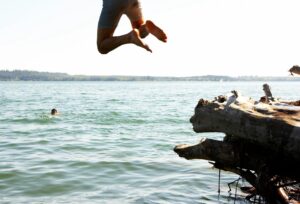Outdoor Enthusiasts, Pet Owners Encouraged to Avoid Harmful Algal Blooms
Kansas Department of Wildlife and Parks
KANSAS CITY, Kan. – Blue-green algae look much like other, more common algae but they’re really a type of bacteria called “cyanobacteria.” And this cyanobacteria, when in high concentrations, can cause illness in both people and pets. That’s why each year, the Kansas Department of Wildlife and Parks (KDWP), Kansas Department of Health and Environment (KDHE), U.S. Army Corps of Engineers (USACE) and the Bureau of Reclamation (BOR) work jointly to alert the public about potentially harmful algae blooms.
The process begins when KDHE is alerted to a potential algae bloom. Staff will deploy to the waterbody in question, conduct the necessary tests and determine next steps. Depending on either the presence of certain toxins, the number of cyanobacteria cells in the water or a combination of the two, KDHE may then issue a Public Health “Watch” or Public Health “Warning.”
But outdoor enthusiasts can protect themselves, and their loved ones – including pets – by remaining vigilant for the signs of a Harmful Algal Bloom before a watch or warning is ever issued.
Here’s what you should know:
- Algal blooms are often highly visible, appearing like a bright green slime on the water’s surface, though blooms come in other colors and textures.
- KDHE monitors blue-green algae across the state April 1-Oct. 31, when blooms are most likely to be present. However, heavy blooms have been documented well into November.
- Dogs can get sick or die from exposure to harmful blue-green algae. It’s recommended that pet owners offer fresh drinking water often to their dogs while out-of-doors to decrease the pet’s interest in drinking from potentially-tainted ponds or lakes. Also, dogs that have swam through possible blooms should be toweled off immediately and taken to a place where they can be sprayed thoroughly with clean water. If a dog exhibits any symptoms such as throwing up, lethargy, or seizures following exposure to a natural waterbody, seek immediate veterinary attention.
- Suspected exposures to blue-green algae can be reported to the KDHE by calling the EpiHotline (877-427-7317) or by using this online form found at: https://kdheks.co1.qualtrics.com/jfe/form/SV_3m9Zfcls27nckMB.
For more information on blue-green algal blooms in Kansas, visit www.kdheks.gov/algae-illness.
For an interactive map of current Harmful Algal Bloom Watches and Warnings in Kansas, visit the KDHE website, https://maps.kdhe.state.ks.us/habkscounty/.

